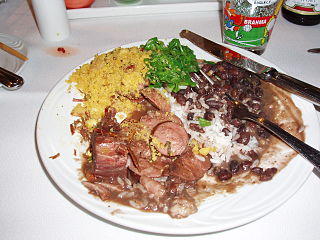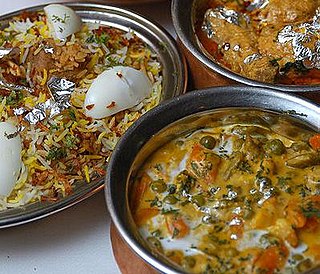This page is based on this
Wikipedia article Text is available under the
CC BY-SA 4.0 license; additional terms may apply.
Images, videos and audio are available under their respective licenses.

American Chinese cuisine is a style of Chinese cuisine developed by Americans of Chinese descent. The dishes served in many North American Chinese restaurants are adapted to American tastes and often differ significantly from those found in China.

Tex-Mex is a fusion of Mexican and American cuisines, deriving from the culinary creations of the Tejano people living in Texas. It has spread from border states such as Texas and others in the Southwestern United States to the rest of the country as well as Canada. Tex-Mex is most popular in Texas and neighboring areas, especially nearby states in both the US and Mexico. The Mexican food market is a 41 billion dollar industry within the United States.

Chutney is a sauce or a dry base for a sauce, originating from the Indian subcontinent, used with the cuisines of the Indian subcontinent, that can include such forms as a spicy coconut dip, a tomato relish, a ground peanut garnish or a dahi (yogurt), cucumber, and mint dip.

Haute cuisine or grande cuisine is the cuisine of "high-level" establishments, gourmet restaurants and luxury hotels. Haute cuisine is characterized by meticulous preparation and careful presentation of food, at a high price level.

Latin American cuisine is the typical foods, beverages, and cooking styles common to many of the countries and cultures in Latin America. Latin America is a highly diverse area of land that holds various cuisines that vary from nation to nation.
Some items typical of Latin American cuisine include maize-based dishes arepas, pupusas, tacos, tamales, tortillas and various salsas and other condiments. These spices are generally what give the Latin American cuisines a distinct flavor; yet, each country of Latin America tends to use a different spice and those that share spices tend to use them at different quantities. Thus, this leads for a variety across the land. Sofrito, a culinary term that originally referred to a specific combination of sautéed or braised aromatics, exists in Latin American cuisine. It refers to a sauce of tomatoes, roasted bell peppers, garlic, onions and herbs.

Canadian cuisine varies widely depending on the regions of the nation. The three earliest cuisines of Canada have First Nations, English, Scottish and French roots, with the traditional cuisine of English Canada closely related to British cuisine, while the traditional cuisine of French Canada has evolved from French cuisine and the winter provisions of fur traders. With subsequent waves of immigration in the 19th and 20th century from Central, Southern, and Eastern Europe, South Asia, East Asia, and the Caribbean, the regional cuisines were subsequently augmented.

The milanesa is a South American variation of an Italian dish where generic types of breaded meat fillet preparations are known as a milanesa.

The following outline is provided as an overview of and topical guide to food preparation:

Regional cuisine is cuisine based upon national, state or local regions. Regional cuisines may vary based upon food availability and trade, varying climates, cooking traditions and practices, and cultural differences. One noteworthy definition is based upon traditional cuisine: "A traditional cuisine is a coherent tradition of food preparation that rises from the daily lives and kitchens of a people over an extended period in a specific region of a country, or a specific country, and which, when localized, has notable distinctions from the cuisine of the country as a whole." Regional food preparation traditions, customs and ingredients often combine to create dishes unique to a particular region. Regional cuisines are often named after the geographic areas or regions that they originate from.
A global cuisine is a cuisine that is practiced around the world. A cuisine is a characteristic style of cooking practices and traditions, often associated with a specific region, country or culture. To become a global cuisine, a local, regional or national cuisine must spread around the world, its food served worldwide. There have been significant improvements and advances during the last century in food preservation, storage, shipping and production, and today many countries, cities and regions have access to their traditional cuisines and many other global cuisines.
Seafood dishes or fish dishes are distinct food dishes which use seafood as primary ingredients, and are ready to be served or eaten with any needed preparation or cooking completed. Seafood dishes are usually developed within a cuisine or characteristic style of cooking practice and tradition, often associated with a specific culture. A cuisine is primarily influenced by the ingredients that are available locally or through trade. Religious food laws, such as Islamic dietary laws and Jewish dietary laws, can also exercise a strong influence. Regional food preparation traditions, customs and ingredients often combine to create seafood dishes unique to a particular region.
The following outline is provided as an overview of and topical guide to cuisines:









